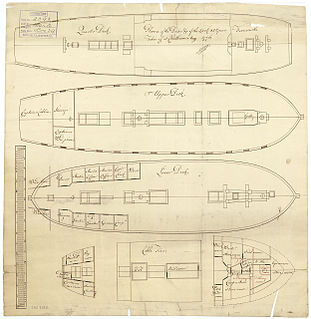
HMS Lark was a 32-gun Richmond-class frigate fifth-rate frigate of the Royal Navy. She was launched in 1762 and destroyed in Narragansett Bay in 1778, during the American Revolutionary War.
Uranie was a 44-gun frigate of the French Navy, lead ship of her two-vessel class.

Var was a corvette of the French Navy, launched in 1806 as the name-ship of her class of flutes. She served as a storeship until the British captured her in 1809. She became the transport HMS Chichester, and was wrecked in 1811.

HMS Manly was an Archer-class gun-brig launched in 1804. During her career first the Dutch captured her, then the British recaptured her, then the Danes captured her, and finally the British recaptured her again. The British renamed her HMS Bold after her recapture in 1813. She was sold out of service in 1814.

HMS Leveret was a Cruizer-class brig-sloop built at Dover, England, and launched in 1806. She was wrecked in 1807.

HMS Foxhound was an 18-gun Cruizer-class brig-sloop built by King at Dover and launched in 1806. She participated in the battle of the Basque Roads in early 1809 and foundered later that year.

HMS Halcyon (1813) was a Royal Navy Cruizer-class brig-sloop that Edward Larking & William Spong built at King's Lynn and launched in 1813. She had one of the shortest lives of any vessel of her class.
HMS Tang was a Royal Navy Ballahoo-class schooner of four 12-pounder carronades and a crew of 20. The prime contractor for the vessel was Goodrich & Co., in Bermuda, and she was launched in 1807. Like many of her class and the related Cuckoo-class schooners, she succumbed to the perils of the sea relatively early in her career.
HMS Wagtail was a Royal Navy Cuckoo-class schooner launched in 1806 by James Lovewell at Great Yarmouth. Like many of her class and the related Ballahoo-class schooners, she succumbed to the perils of the sea relatively early in her career.
HMS Mandarin was a Dutch gun-brig of 178 tons burthen (bm) and 12 guns that the British had captured at Amboyna in February 1810. She served as part of a four-vessel flotilla that captured Banda Neira. She was wrecked in November 1810.

HMS Placentia was the name-ship of her two vessel class, with both vessels being launched in 1789. John Henslow designed the small sloops for coastal patrol duties off Newfoundland. She was wrecked in 1794.
Premier Consul was a French privateer launched in 1800 at Nantes. The Royal Navy captured her in 1801 and renamed her HMS Scout. She foundered later that year with the loss of her entire crew.

HMS Delight was a British Royal Navy 16-gun brig-sloop of the Seagull class launched in June 1806, six months late. She grounded off Reggio Calabria in January 1808 and was burnt to prevent her being salvaged.
César was a mercantile brig launched in 1802 that the French Navy purchased at Bordeaux in 1803. The Royal Navy captured her in July 1806 and took her into their service, but she was wrecked in early 1807.

HMS Alert was launched in 1793 for the Royal Navy. In May 1794 the French Navy captured her and took her into service as Alerte. A few months later the Royal Navy destroyed her.
HMS Augustus was a Thames sailing barge that the British Royal Navy purchased in 1795 and used as a gun-vessel of two or three guns. She was under the command of Lieutenant James Scott when she was wrecked at Plymouth on 7 July 1801.
HMS Orestes was a mercantile vessel, possible Ann, that the Royal Navy purchased in 1803. She had a short operational career; her crew burnt her in 1805 after she ran aground to prevent the enemy from capturing her.
HMS Racer was a Decoy-class cutter launched at Sandgate on 24 April 1810. Lieutenant Daniel Miller commissioned her, probably in May. The French captured her on 28 October when she stranded on the French coast.
HMS Ariadne was launched at Cowes in 1803 as the civilian vessel Ariadne. The Royal Navy purchased her in July 1805 as an advice boat and commissioned her under Lieutenant John Wells. It renamed her HMS Dove later that year, and then in 1806 renamed her HMS Flight.
HMS Martin was launched in 1805 at Dartmouth. Commander Roger Savage commissioned her in February and sailed for the Mediterranean on 18 April.
This page is based on this
Wikipedia article Text is available under the
CC BY-SA 4.0 license; additional terms may apply.
Images, videos and audio are available under their respective licenses.







